by Editor | Oct 22, 2012 | Accomodations, Attractions, Restaurants and Food, Spas
Article and photos by Elena del Valle
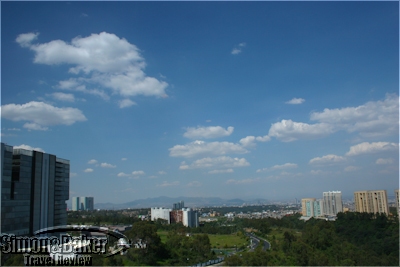
The view from the rooftop of our Santa Fe hotel
It had been years since my last visit to Mexico City. After the immigration desk I made my way into the customs area where I first noticed the new airport building. I later discovered Terminal 2, spacious and new looking, was only several years old and said to already be struggling to accommodate traffic. After a few minutes my suitcase rolled out and I walked to the customs area where my luggage, check-in and carry-on, had to pass through an x-ray machine. Then I was asked to press a green button before I could continue. Depending on the response I might be subjected to further inspection, one of the customs staff explained.

From the rooftop of The Westin I watched the sunrise over Santa Fe
No further inspection was required although my wireless keyboard attracted the customs staff attention for some reason. As I exited the customs area I searched the crowd for someone with a sign. Fidencio, my driver that day, and an assistant greeted me warmly. From the airport to The Westin Santa Fe Mexico City (Av. Javier Barros Sierra # 540, Lomas de Santa Fe, Mexico City 01219 México, DF, +52 55 50 89 80 00, fax +52 55 50 89 80 58, www.westin.com/santafe, westin.santafe@westin.com), my hotel for the first night, the private transport took 90 minutes. As we drove I looked around and realized I hardly recognized the traffic jammed buzzing metropolis. From my tenth story 34 square meter Deluxe Room, on a Starwood Preferred Guest floor, I had a splendid view of Santa Fe, a recently built booming business neighborhood. The hotel itself had only been established in August 2010.

There were flower arrangements in the hotel common areas
Dinner with the group of four I was joining, wasn’t for several hours so I ordered a room service club sandwich with fries. Within minutes I was munching the hot and yummy comfort food and a few welcome sweets I found in my room to tide me over until dinner. From Santa Fe to the La Roma neighborhood multi-level home of Chef Monica Patiño where we were having a private dinner it was an hour’s drive, less on the drive back once the traffic had quieted down.
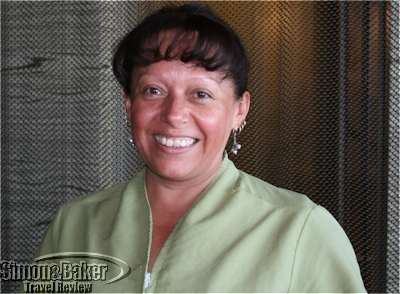
Griselda, my masseuse at Heavenly Spa
The following morning I rose early to catch the colorful sunrise view and work out at the hotel gym on the top floor before heading to the buffet breakfast at the ground floor restaurant. By 10:30 a.m. I was enjoying a good deep tissue massage with mini facial (not a favorite) courtesy of Griselda at the Heavenly Spa Westin, the hotel’s penthouse spa.
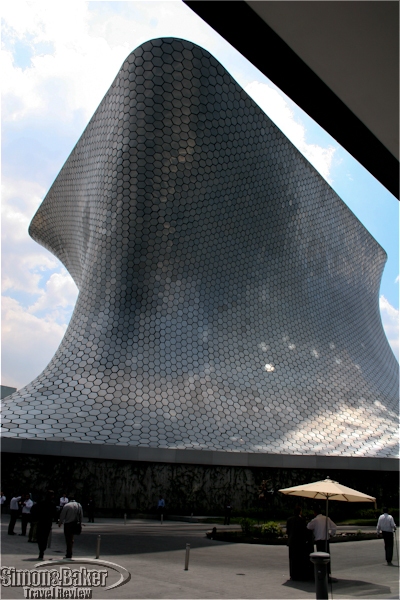
The exterior of the Soumaya Museum
By midday we checked out, leaving Santa Fe behind, making our way through heavy traffic for one hour to Museo Soumaya (Soumaya Museum), a 14-month old six-story structure housing fine art originals, mostly European and Mexican.
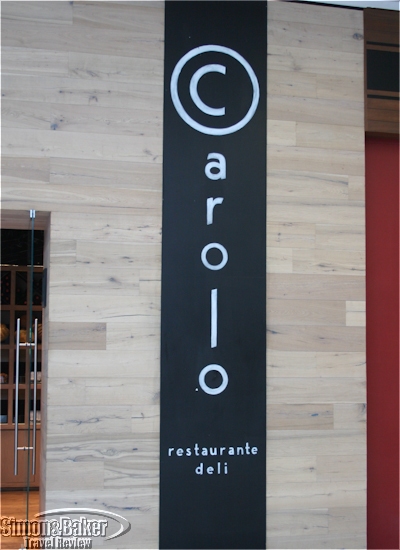
The entrance to Carolo Carso within a shopping mall and mixed use complex
From the museum we walked to Carolo Carso (Miguel de Cervantes Saavedra 303, Polanco, Mexico City, D.F., 11529, Mexico, +52 55 49 76 01 34, www.carolo.com.mx, info@carolo.com.mx), a Mediterranean style open air casual restaurant with an upper level view of the museum, within a large mixed use complex. It was one of several Carolo restaurants in the Mexican capital. Lunch consisted of a series of appetizer style dishes shared by the table occupants: Ensalada Chop (Chop Salad), Cuadritos de Atún (Tuna Squares), Mosaico de Salmones (Salmon Plate), Carpaccio de Res (Beef Carpaccio), Tacos de Rib Eye (Rib Eye Tacos), Tacos de Pato (Duck Tacos), Pizza Margarita (Margarita Pizza, a favorite), Risotto de Alcachofa (Artichoke Risotto, a favorite), Tostadas Orientales (Oriental Toasts), and Carmarones a los Tres Chiles (Shrimps in a Three Chili Sauce). Desserts too were set in the middle of the table for communal sharing: Pastel de Coco (Coconut Pie), Príncipe Alberto (Prince Albert Cake), Key Lime Pie, and Pastel de Tres Leches (Three Milks Cake).
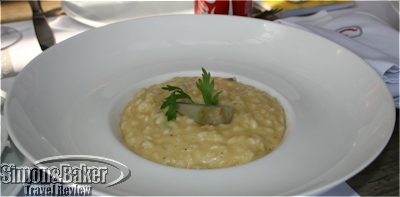
Artichoke Risotto
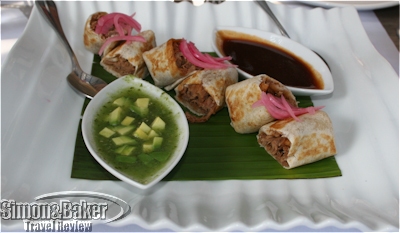
Lunch at Carolo Carso
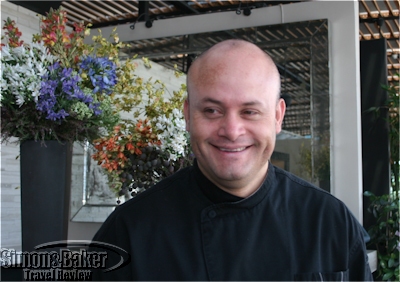
Marco de la O, executive chef, Carolo Group
At the end of the meal we had an opportunity to meet Marco de la O, executive chef, Carolo Group. A native of Puerto Vallarta, Jalisco he studied at the Universidad Anáhuac and at Panamericana de Hotelería in Mexico. De la O, who strives for excellence in quality, flavor and presentation, started his career at the Nikko Hotel in Mexico City. Later he worked at the Four Seasons in New York before returning to Mexico City.
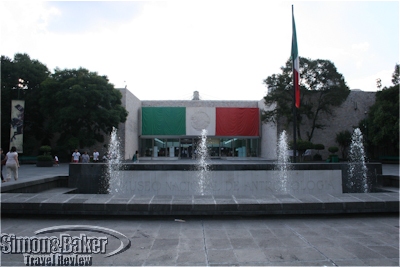
The entrance of the Anthropology Museum
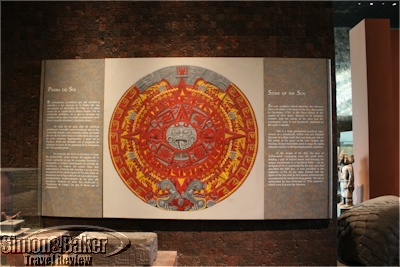
A representation of the Stone of the Sun at the Anthropology Museum
After lunch, we headed to the famous Anthropology Museum (Museo de Antropología) where Laura, a knowledgeable and patient guide escorted us to the Sala Maya (Maya Hall) for an outstanding, though brief because we arrived late, guided visit. A thirty minute drive saw us at the entrance of The St. Regis Mexico City hotel (Paseo de la Reforma 439 Colonia Cuauhtemoc Mexico City, Federal District 06500,Mexico, +52 55 52 28 18 18, fax +52 55 52 28 18 26, www.stregis.com/mexicocity, mexico.city@stregis.com) facing the Diana the Hunter (Diana La Cazadora) roundabout water fountain for check-in on the third floor of the tall building.
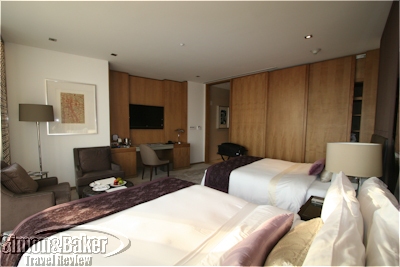
My room at The St. Regis Mexico City
The hotel’s spacious common areas were filled with sunlight, works of art and pretty flower arrangements. Friendly uniformed staff greeted us when we reached the lobby and escorted us to our respective accommodations following check-in procedures. The floor destination had to be selected on an outer panel with the electronic key card before entering the elevator, my staff escort explained.
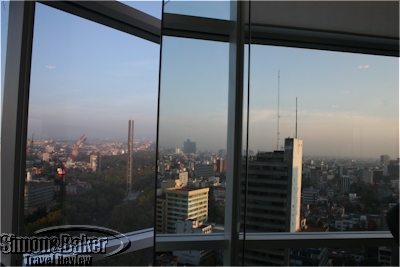
Mexico City seen from the St. Regis gym
Among my favorite features of the hotel were the lobby level views of the water fountain and the panoramic views of the city from the 15 floor work out rooms and adjacent pool area. From my twelfth story 50 square meter (538 square foot) Deluxe Room, on a Starwood Preferred Guest floor, I had a splendid view of Paseo de la Reforma and the surrounding neighborhood. Muted city sounds reached inside. Complimentary amenities on my floor were butler service, on demand 24-hour complimentary hot beverage service and the pressing of two items during my stay, my butler explained. The dimly lit room decorated in natural colors had thick double curtains to fend of the harsh sunlight, two double beds with thick plush mattresses and feather pillows, and a spacious marble bathroom with bathtub and separate shower, as well as a small remote controlled television screen built into the oversize mirror behind and between twin sinks. The new looking hotel dated to August 2009.

A black bean and foie gras appetizer at Dulce Patria
Dulce Patria restaurant (Anatole France 100, Col. Polanco, 11560, Mexico City, Mexico, +52 55 33 00 39 99, fax +52 55 33 00 39 95, www.dulcepatriamexico.com, kosberg@dulcepatriamexico.com), where we had a refined Mexican meal, was only twenty minutes from the St. Regis. Shortly after breakfast the following day we drove forty-five minutes across town to the Mercado de San Angel, a large covered odorous market filled with fruit and vegetable, fish, meat and a variety of other vendors.
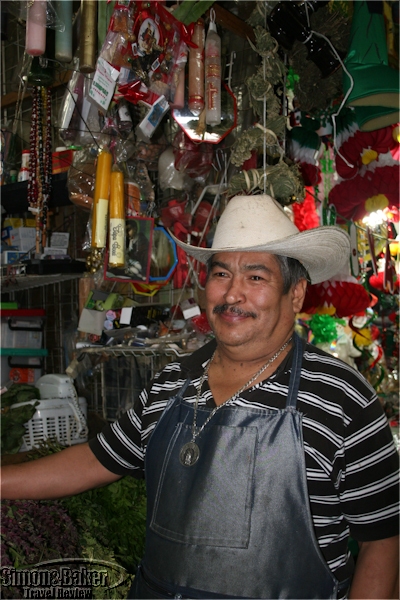
Margarito Angeles Ramirez sold herbs at the market
Our first stop was at the stall of Margarito Angeles Ramirez who, after learning the skill from his grandmother, for 22 years had sold herb blends at the Mexico City market. A large mound of fragrant fresh herbs occupied the front of his stall which was chock full of items all the way to the rear wall and from the ceiling down. A variety of amulets, candles, dried herbs and plastic wrapped items took up most of the small space that was sandwiched between other market vendors down a narrow passageway. While we learned about his services, in Spanish, from Margarito several customers came by, squeezing through the tight space where we stood, to pick up their herb blends and orders.
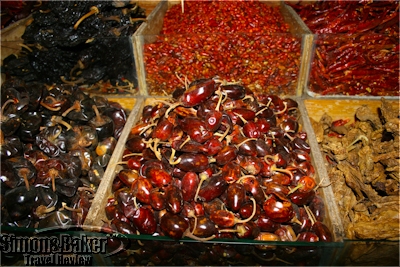
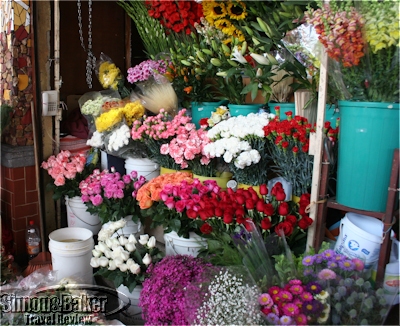
Vendor stalls at the Mercado de San Angel
With herbal blends, Angeles Ramirez said, he could, like a pharmacist, alleviate ailments such as allergies, migraines, headaches, indigestion and minor aches. He also provided mystical or magical white magic Santeria potions for good luck charms, attraction, and love. Prices ranged from five pesos to twenty thousand pesos. Some blends could be prepared while the customers waited while others required twenty days to be ready.

An unusual stop
From the market a short walk led us to the Public Baths (Baño Público), a fee based public steam and Turkish bath facility the owner kindly, if reluctantly, allowed us to visit. The San Jacinto Parrish (Parroquia de San Jacinto) was our next stop. Built atop an Indian temple the church, our guide explained, was important because it was at commercial crossroads of the 1500s. The church, as many others in the city, he said, had suffered severe damage in the early twentieth century although several original structures remained.
From the church we walked back a few blocks to the Saturday Bazaar (Bazaar del Sábado), a popular weekly indoor and outdoor arts and crafts market, where we spent the better part of an hour before heading to lunch at Azul Condesa, one of several Azul restaurants headed by Chef Ricardo Muñoz Zurita, in the Condesa neighborhood.

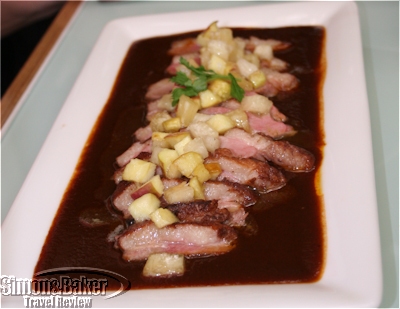
Favorite dishes at Azul Condesa
At lunch, we sat in an open air interior courtyard. Every table was full and the volume was so loud I could only hear my immediate neighbors at the table. Appetizers included several Yucatan dishes: Sope de Cochinita Pibil, a bite size morsel of succulent shredded pork topped with red onions that had been marinated in Yucatan bitter orange atop a sope, corn made bread cooked on a skillet; Sope de Hongos, a mushroom topped sope; and Salpicón de Venado, a European venison morsel made with onion, tomato, spicy chilies served with avocado and tortilla chips. My favorite was the Sope de Cochinita Pibil.
For starter I ordered the creamy Cream of Cilantro Soup served with toasted almonds, one of few non hot items on the menu. I sampled my neighbor’s juicy Duck Confit served with a red berry and plum sauce (a favorite) and my own dish, Roasted Skirt Steak served with home fries. From the dessert menu the server recommended Soursop Foam with a red berry sauce. Chili candies were served with coffee at the end of the meal.
by Editor | Oct 1, 2012 | Restaurants and Food
Article and photos by Elena del Valle
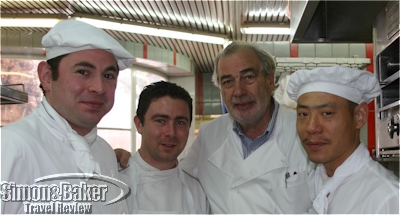
Marc Meneau (third from the left) and his chefs
While I was at Domaine de L’Espérance Marc Meneau in the village of Saint Pere sous Vezelay in Burgundy, France I had a chance to visit the kitchen and see two chefs, including Marc Meneau, the executive chef and owner, at work one morning. I had dined at the restaurant (see Garden side dining at famed Burgundy restaurant) during my stay at the hotel (see Boutique Burgundy hotel offered elegant accommodations, gourmet meals, area tours) and was intrigued to watch the kitchen staff in action. I was the sole visitor to take advantage of the restaurant cooking demonstrations that day. It had been raining almost incessantly since I arrived in France and I imagined the quiet ambiance at the hotel would disappear once the skies cleared.
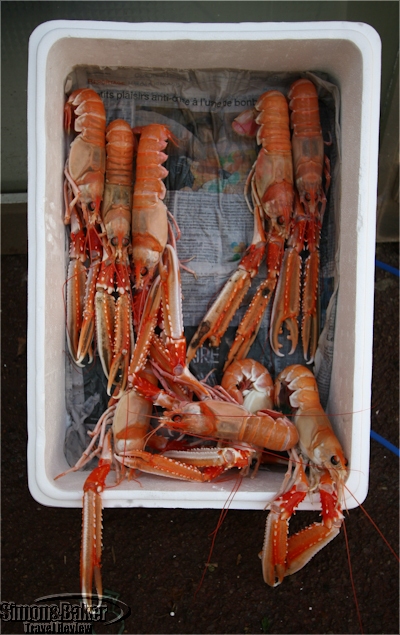
Inside the insulated boxes was a treasure trove of seafood
Shortly after I arrived in the kitchen the seafood delivery truck staff began unloading their precious coastal cargo and the chef asked if I was interested in watching them process their order. I would be delighted to observe, I responded, and we descended a few stairs to the back of the restaurant, making our way toward a stack of Styrofoam containers that had just been delivered.
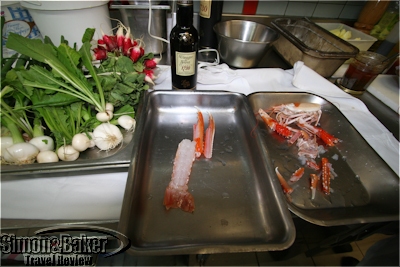
The ingredients for that morning’s dish
Almost at the same time a handful of diligent staff members began counting, sorting and storing the chilled seafood. Within minutes everything was organized and the truck had departed. The chef selected three langoustines from the just arrived boxes for that morning’s demonstration which I had the pleasure to observe and taste hot just off the stove.

From delivery to ready in minutes
Just as I finished tasting the langoustine dish, standing in a corner of the kitchen, Chef Meneau arrived. A tall imposing figure with seemingly infinite amounts of energy he walked at a brisk pace instructing staff as he moved from one side or the other of the brightly lit kitchen like a whirling dervish. One moment we were in the kitchen and the next we were walking in the chilly outdoors, visiting his organic garden. Most of the fruits, herbs and vegetables served in the restaurants, he explained, were grown on the property. As we walked we met one of the gardeners tending to the budding greens. That explained the tender, crispy and flavorful produce I had tasted at meal times.
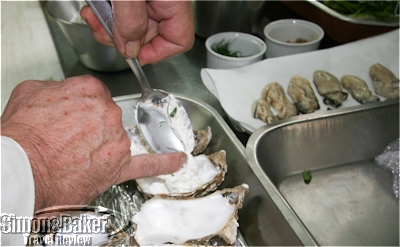
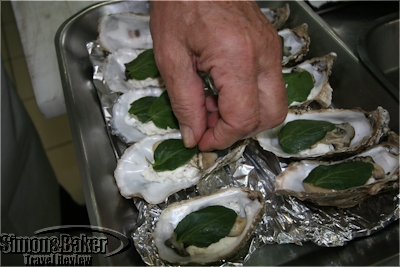
Marc Meneau demonstrates the preparation of his popular Huites en gelée d’eau de mer oyster dish
Moments later, we were back in the warm kitchen and the chef invited me to watch him prepare his well known oysters in sea water dish. The secret, he said as he began, is never to wash the oysters but instead allow them to keep their natural ocean flavor. The ingredients were fresh oysters and their washed, brushed shells; gelatin sheets, shallots, white wine, cream, lemon juice, chopped watercress leaves, toast and Camembert cheese.
by Editor | Apr 30, 2012 | Restaurants and Food
Article and photos by Margot Liebman

The entrance to Eataly from 23 street
Eataly was the perfect combination of old-world European market and true Manhattan glamour. Centrally located on 23 Street, one of the main cross-town routes in New York City, it was easy to get to and fun to visit. I went with friends on a Saturday afternoon in October, a popular time to go, and again in March. It seemed to me that locals and tourists were visiting Eataly.

An example of the signage scattered throughout Eataly
When I walked in I noticed two things, an exquisite selection of produce and a huge crowd. I admit that I panicked, but only momentarily. After marveling at the orange chanterelle mushrooms, baby purple artichokes, and tiny rock-like potatoes, I made my way into the main part of the market.
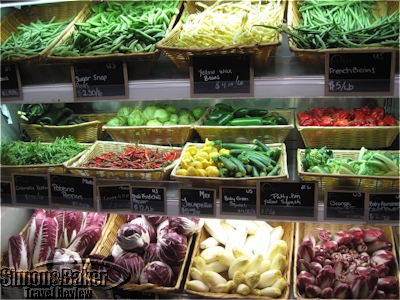
The produce display near Eataly’s main entrance
The entire place was over 50,000 square feet (4,600 square meters) with high ceilings and pools of light. There were marble tables, white walls, stainless steel shelves and an abundance of food. The market sections had packaged pastas, sauces, olives, meats, sweets and many imported items. There was a Gelateria (Italian ice cream section), an espresso bar, a chocolate counter, a fishmonger, a butcher, and a bookshop. It was a bit overwhelming, but after I took some time to wander around I got the lay of the land.

One of the pasta aisles in the market
There were six restaurants, each one focusing on one type of food. Il Manza (reservations were required for this one), Il Pesce (Italian for the fish), Le Verdure (Italian for vegetables), Birreria (Italian for the beer place), La Piazza (The Plaza, selling sandwiches and charcuterie products) and La Pizza & La Pasta. We found a spot at the bar at Il Pesce where we had a direct view into the kitchen.
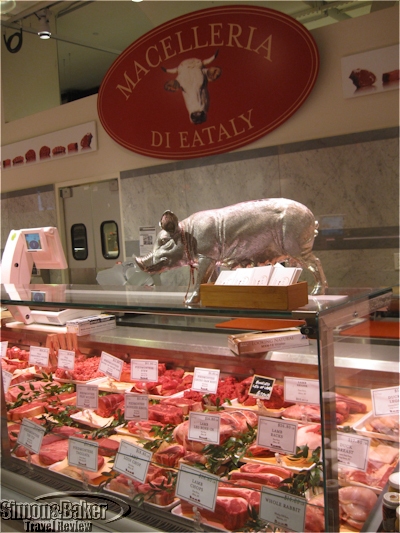
Macelleria, where you can buy fresh red meat
To start we ordered a raw fish selection that included sea bass and tuna topped with tiny roe and a citrus glaze. It was better than my favorite sushi restaurant. Next was a whole branzino (a silver-skinned fish found in European sea and saltwater lakes) prepared simply on a salty bed of paper-thin potatoes. We also ordered grilled scallops in a lemon and butter sauce served in a large seashell. On the side we had a bed of sautéed, garlicky mustard greens. The fish was fresh and flavorful, and each dish complemented the other. The service was fast and friendly and we had a great time watching the chefs prepare each plate.
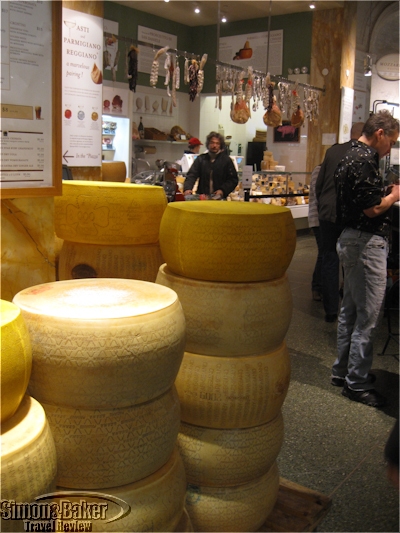
Rounds of cheese stored near the wine bar
Next, we toured the market. On some days Eataly offered classes. I planned to check the website’s Learn section for a schedule of upcoming programs. In the past, topics have ranged from olive oil tastings to cooking classes, to history of Italian Cuisine with prices between $60 and $275.
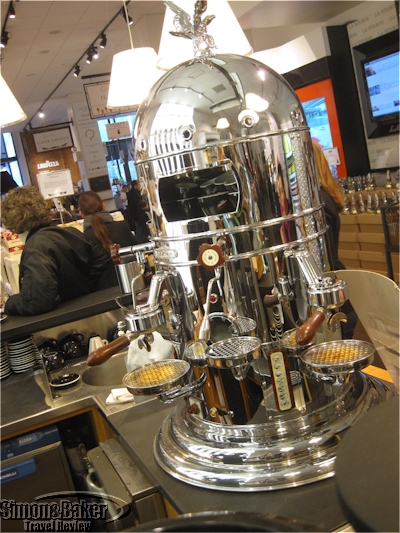
The antique-style espresso machine made a delicious cappuccino!
That day there was a free grappa tasting so we tasted a few sweet liquors like Strega and Limoncello. Next we made our way to the espresso bar where coffee was served from an antique-style machine. Of course, we also had to try the Gelateria and helped ourselves to a raspberry and chocolate double-scoop; when I closed my eyes I thought we were eating a real raspberry.
Overall, Eataly appeared to me to be a food-lover’s paradise. Offerings the day I was there were high quality, exotic, fun and well organized. Staff served the food quickly. We paid the kind of high prices we have paid at upscale Manhattan food shops.

Mushrooms, artichokes and dried peppers in the produce section
Eataly was founded and created by Oscar Farinetti, an Italian entrepreneur. His partners included Mario Batali and Lidia Bastianich, celebrity chef and restaurateur respectively, as well as Joe Bastianich, a restaurateur and Lidia’s son. I liked that Eataly partnered with Slow Food, a nonprofit organization founded to counteract fast food and fast life.
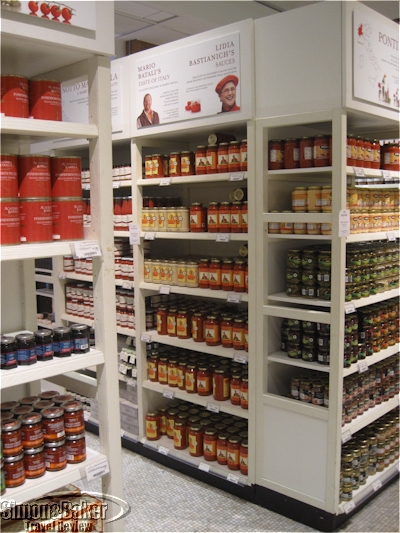
The store offers many imported goods such as these pasta sauces
I will return because I had so much fun exploring the whole place and I would like to try the other restaurants. If I were in the neighborhood, I might stop in just for a scoop of gelato at Eataly NYC (200 5th Avenue, New York City, (212)229-3560, info@eataly.com, www.eatalyny.com).
by Editor | Mar 19, 2012 | Accomodations, Restaurants and Food
Article and photos by Elena del Valle
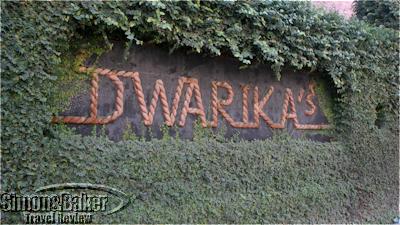
The entrance to Dwarikas
To reach Nepal from the United States east coast I traveled many hours with several stops along the way. When I arrived, the sweltering Kathmandu airport seemed chaotic and on exiting I, at first, missed my guide in the sea of unfamiliar faces. Narrow city streets shared by all manner of vehicles honking intermittently and livestock provided my first impression. I was excited to have secured accommodations at my first choice of the bustling city’s luxury hotels. For my arrival day the hotel had been fully booked until a last minute opening made it possible to secure a reservation for my entire stay in Kathmandu.
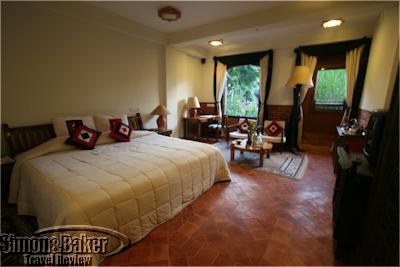
My first room had a view of the pool
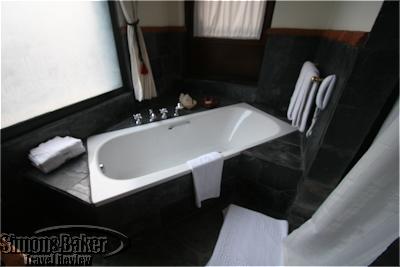
My bathtub at Dwarikas
In my sleep deprived and jet lagged state little enthusiasm to explore remained and I desperately wished for a clean and quiet place to call my own, at least for a few hours. That was not to be the case, at least not right away, as my room was not ready, literally. Workmen were putting the finishing touches on the newly constructed room (and building) assigned to me at Dwarika’s Hotel. One of the staff was kind enough to notice that I was tired and offered a temporary solution, a room where I could rest for 90 minutes until mine became available at 6 p.m.
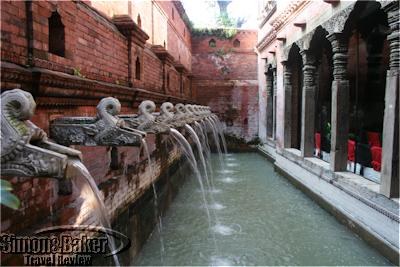
Fountains in a courtyard of the hotel
My rooms (I stayed at two rooms. At the staff’s suggestion I was relocated from my original room after the first night due to the loud sounds of construction in my building) were handsome, spacious and comfortable with modern amenities like a mini bar and internet access (for a fee). The breakfast buffet offered a variety of local and international selections. I especially enjoyed breakfast and opted for fresh fruit and the Nepali items like cheeses and pastries.
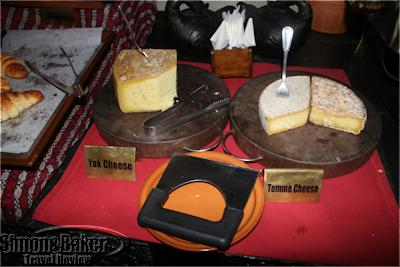
There were Nepali cheeses at breakfast
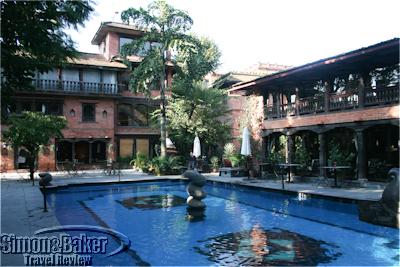
The Dwarika’s pool was adjacent to one of the restaurants
One night during my stay I had dinner at Krishnarpan, the hotel’s gourmet Nepali restaurant. After removing my shoes at the entrance of the restaurant there was a brief ceremonial “hand washing” before I was escorted across the wood floor to a ground level table. The candlelit room was decorated in wood and red tones. Prettily dressed staff ladies who spoke some English looked after guests.
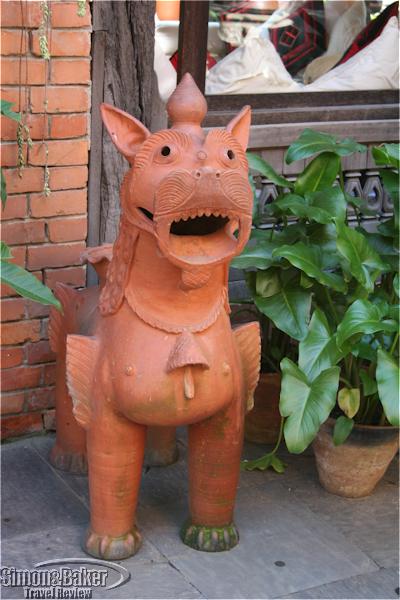
A sentinel in the common areas
It was necessary when booking my reservation with the front desk to decide which of the set menus I would have for dinner. While I was eager to sample Nepali dishes I chose the most modest, the six course dinner, on the staff’s recommendation. It consisted of: Samaya Bajee, an assortment of Nepali hors d’oeuvres served during religious ceremonies; Chyau Ko Sekuwa, Pan grilled oyster mushroom finished with fresh cream (a favorite); Roti, Unleavened griddle roasted bread; Momo, Potatoes and chickpeas cooked with Nepalese spices; Tarkari Ko Jhol, Vegetable soup cooked with Nepali spices (a favorite); Sada Bhuja, Organic steamed rice; Dal Jhaneko, Organic lentil tempered with Himalayan herbs; Kukhura Ko Masu, Traditional Nepali chicken curry cooked with aromatic Nepalese herbs and spices; Saag Jhaneko, Sauteed organic spinach with Nepalese spices; Aloo Ra Parwal Tareko, Stir fried potato and mini gourd; Eskush Ra Bhatamas Ko Tarkari, Sweet gourd and soyabean cooked with Nepali spices; Mis Mas Achar, Homemade vegetable pickle; Lapsee Ko Achaar, a very spicy Homemade hug-plum pickle; Sikarni, Fresh yoghurt flavored with cinnamon sweetened with honey; and Chiya wa Kafi, tea or coffee. Although almost all of the dishes were spicy and hot it was a most enjoyable meal served by attentive staff in an attractive dining room.

A special area was dedicated to the founder of the hotel
Named for Dwarika Das Shrestha, its founder, Dwarika’s Hotel in Kathmandu was outstanding for its combination of luxury features and facilities including a spa, heritage design, well appointed rooms, service and foodie oriented offerings. As I traveled around Nepal I realized how special Dwarika’s was and missed it.
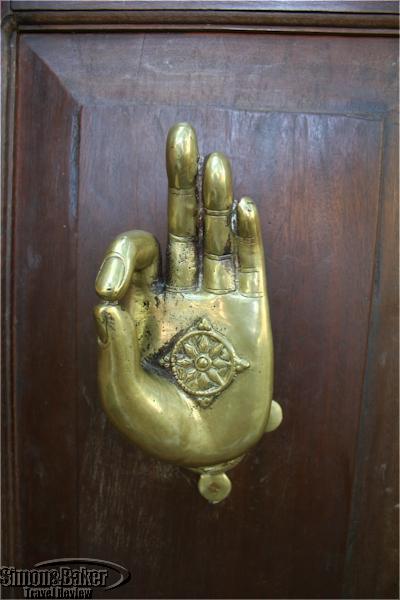
One of the many decorative touches
In addition to the architectural and artistic design features, including original thirteenth century artifacts and replicas, which lent the urban hotel a historic and cultural air I enjoyed Dwarika’s for the understated casual luxury, safety features and delicious food. Should I find myself in Kathmandu again this would be my first option for accommodations. Dwarika’s Hotel, P.O. Box P.O.Box-459, Battisputali, Kathmandu, Nepal, + 977-1 4479488/ 4470770, fax + 977-1 4471379/4478378, http://dwarikas.com, info@dwarikas.com
by Editor | Nov 1, 2010 | Restaurants and Food
Article and photos by Elena del Valle
On a recent trip to Phuket, Thailand I dined at The Boathouse, a well known beach side restaurant on the southwestern coast of the island. I sampled the restaurant’s two tasting menus, French and Thai, with wine pairings. Several days later I followed up the success of the meal with a 90-minute cooking class and lunch.
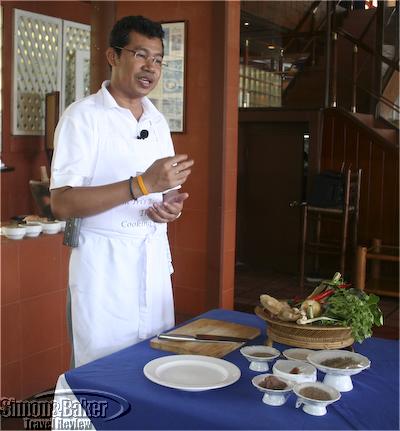
Chef Punchun discusses ingredients
The following Saturday morning I returned to learn about Thai cuisine first hand from Tummanoon Punchun, the restaurant’s executive chef at the time. Since then the chef relocated to Chiang Mai in northern Thailand and Jean-Noël Lumineau, a French chef living in Phuket, took over The Boathouse kitchen. Khun Rattana Pholtaisong, the sous-chef who started working at the Boathouse in 1990 and assisted Chef Punchun during his tenure, has taken over the weekend Thai cooking classes.
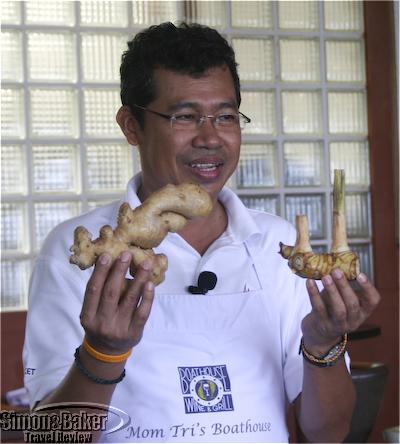
Each ingredient was discussed in detail
For more than a decade, Chef Punchun shared his passion for Thai food and cooking with food enthusiasts during weekend Thai cooking classes in English (the chef had a thick Thai accent and spoke quickly requiring close attention) from 10 a.m. to 2 p.m. each day. The class I attended was a step-by-step, hands-on session with six English speaking travelers. During most of the 90-minute workshop we sat at a small table in the rear of the restaurant facing Kata Beach. On one side there was a table with a place for each of us to assemble dishes; on the opposite side of the room there were raw ingredients and a cooking section with a sink (to wash our hands after each recipe) where the chef demonstrated how the Thai dishes he had selected should be prepared.
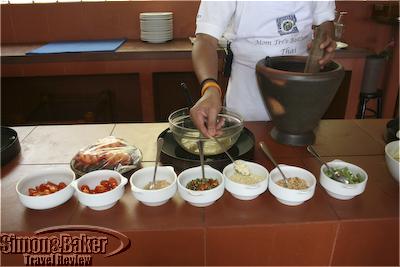
Samples of the food were cooked by the chef
After discussing the menu for the class and the material he would cover the Thai chef shared information about the identification and selection of ingredients when shopping (including options for those of us who were unable to purchase fresh ingredients in our home countries), how best to store each ingredient, ingredient pairings and methods of chopping, dicing and pounding them. He also identified the primary tastes, hot, sour, sweet, salty, bitter and aromatic flavors and discussed how ingredients interact with one another.
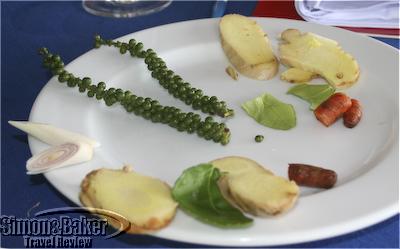
Samples of the common ingredients for the class to examine
He passed around fresh ingredient samples for us to touch and smell. Next the chef showed the class how to prepare a dish before inviting us to prepare it ourselves with his and his staff’s assistance. Then he cooked a small quantity of the items we had prepared so we could taste them before moving on to the following recipe.
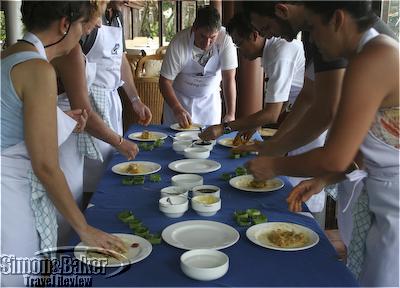
The class prepared each recipe together
When he completed the workshop and answered questions the chef departed, inviting us to relax for an hour until the lunch we had made was cooked in the kitchen and served to us in the dining room. The two-day workshop (Saturday and Sunday) cost 3,500 baht per guest and the one day workshop cost 2,200 baht per guest including lunch at the end of the workshop, an apron, a print out of the recipes and a customized certificate.
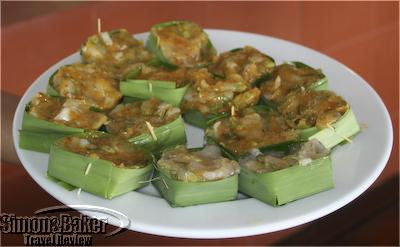
The food prepared by the class went to the kitchen to be cooked
The idea behind the two-day cooking class is for students to learn ten recipes during the two days. During our Saturday session we learned about Thai ingredients, appetizers and salads. The second day, which I missed because I was leaving Phuket that day, featured recipes for main courses and desserts.
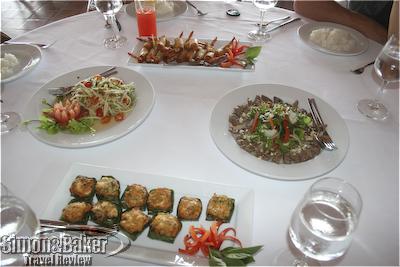
The class consumed the cooked results of their work
You can read more about my meal at The Boathouse at the Simon & Baker Travel Review.
by Editor | Oct 18, 2010 | Accomodations, New Articles, Restaurants and Food, Spas
By Elena del Valle
Photos by Gary Cox

The Breakers Palm Beach
This family owned and family friendly resort in tony Palm Beach Island in Florida’s east coast made fans out of us. There are many reasons to like the 140-acre property such as its handsome Italian design interiors and pretty rooms, beachfront location, two 18-hole championship golf courses, ocean facing swimming pools, spacious spa, boutiques and multiple restaurants. Our favorites: the manicured look pervasive throughout the resort including uniformed staff and the high level of service, often friendly and helpful, wherever we went.

There were many comfortable areas to relax and enjoy the property
We enjoyed a midweek stay just as the season was closing and although the weather did not cooperate as much as we would have liked (there was a constant lifeguard red flag during our stay) we appreciated the calm environs. We particularly enjoyed massages at the resort spa, a sunset dinner at the The Flagler Steakhouse and a molecular gastronomy tasting menu dinner at L’Escalier, the resort’s gourmet restaurant.

Cuisine as art at L’Escalier
Another favorite was a day at Beach Bungalow 17, one of several day rental cabanas fronting the adult relaxation infinity pool and facing the beach beyond. The bungalow provided quiet space aside from the crowded pool area and the private area with a concierge made our time under the sun especially relaxing. The 150-square foot indoor area plus a segregated patio was stocked with some complimentary amenities and plenty of pool towels. For sun time the patio had three outdoor lounge chairs and an umbrella.
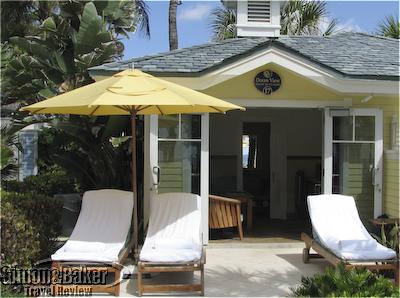
Beach Bungalow 17
Inside the open air space had a ceiling fan and a tower fan, lanai, armchair, rectangular wood table, private outdoor shower, water closet and sink, binoculars, house brand toiletries (body lotion, bathing gel, shampoo, conditioner, liquid soap), blow dryer, tissue paper, WiFi connection, LG flatscreen television with satellite connection, Zenith DVD player, fruit bowl, ice bucket and mini refrigerator stocked with house brand purified complimentary water. There were also four types sodas and snacks in our bungalow for purchase (Snickers, Skittles, Reese’s, M & M and PowerBar).
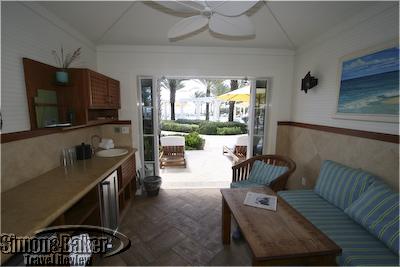
Our view of the pool and ocean beyond from inside the bungalow
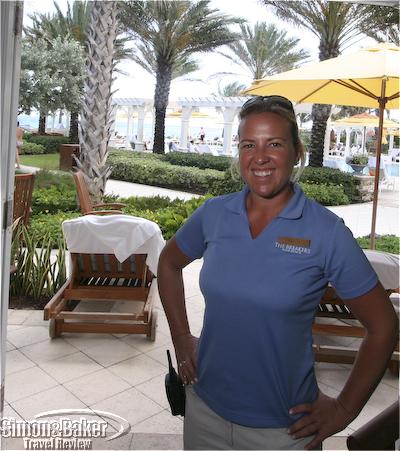
Krissy, our Bungalo concierge, made sure we had everything we needed with a smile
Although the resort facilities and amenities were within easy reach it was nice to know we did not have to do anything or go anywhere if we did not care to. Even lunch was easy.
We selected Florida Fish Tacos, Turkey Club Wrap and a side order of Avocado Fries from the Ocean Grill menu in our bungalow and placed our order with Krissy, a uniformed concierge who checked on us regularly. Within minutes our food arrived. In case we were still peckish around 3:30 p.m. she brought a styrofoam plate of frozen grapes. We wrapped up our day feeling lazy and relaxed and ready for dinner at Echo, the resort’s offsite Asian eatery a short shuttle ride away in downtown Palm Beach. Click here to read about our experience at The Breakers Palm Beach, The Spa at The Breakers and L’Escalier.

The duck at Echo was served with flour wraps and crisp vegetables

































































